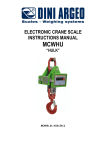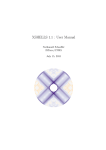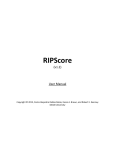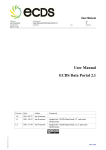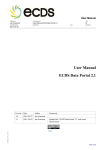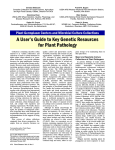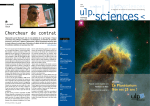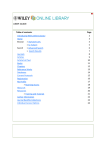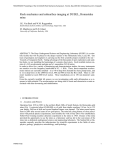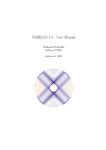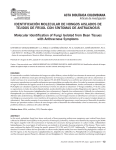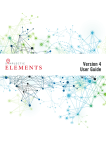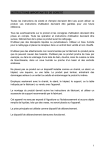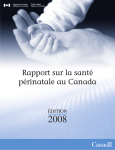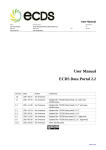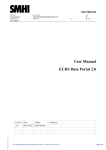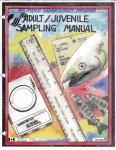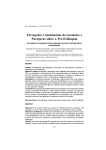Download FACETS ITAs - Canadian Science Publishing
Transcript
Instructions to Authors Table of Contents Journal Information 4 Scope Publication frequency Types of papers Copyright, licensing, and reuse of materials published in FACETS Article processing charges Journal contact information Sections and Subjects 6 Tips for Maximizing Discoverability (metadata) 7 Introduction Titles Abstracts Key words Plain language summaries Manuscript Submission Information 8 Requirements for submission English language improvement service New manuscripts Revised manuscripts Accepted manuscripts Cover Letter Data availability and archiving (depositing your data in a repository) Peer Review and Evaluation Process 11 Instructions to Authors TOC | Publication Procedures 12 Process Proofs Maximizing the visibility and impact of your published articles (Kudos) Reprints Correspondence with Canadian Science Publishing about published papers Ethics and Permissions 13 General ethical standards Duplicate and prior publication Plagiarism Assurance of authorship Conflict of interest and disclosure Experiments involving humans or animals Endangered species Field research permits Archaeology and palaeontology research Obtaining use permissions from a third party Photo manipulation How to Organize Your Manuscript General guidelines Title page Abstract Key words Plain language summary Introduction Materials and methods Results Discussion and conclusions References Tables and figures Appendices Supplementary material 15 Instructions to Authors TOC | Manuscript Style and Formatting Guidelines 19 Preparation of graphic files Preparation of multimedia files Spelling Units of measurement Symbols Abbreviations and acronyms Equations Taxonomy Nomenclature Manuscript Submission Checklist 24 Instructions to Authors | Journal Information Scope FACETS is a multidisciplinary and interdisciplinary science journal that will initially focus on six research areas: Biomedical and Health Sciences; Biological and Life Sciences; Earth and Environmental Sciences; Physical Sciences; Engineering,Technology, and Mathematics; and Integrative Sciences (including topics such as science and policy, and science communication). Although not officially covering Social Sciences and Humanities (SSH) topics, the Integrative Sciences section will include intersections of science and the social sciences. Additional subject categories will be added as the journal evolves in conjunction with emerging scientific advances. FACETS will appeal to researchers studying in a variety of fields looking to publish and read multidisciplinary and interdisciplinary research. Publication frequency FACETS is an open access peer-reviewed journal with a continuous publication schedule wherein articles are published as soon as they are ready. Articles requiring publication at a specific time (e.g., press released content) may be an exception. The journal publishes in electronic format only. Types of papers FACETS is a peer-reviewed, multidisciplinary open access science journal that publishes the following article types: A research article reports a completed definitive study. Authors are strongly encouraged to be as concise as possible; most papers of this type are expected to be between 8000-10,000 words, on average. A surcharge may apply on very lengthy articles to cover the additional production costs; please contact the editorial office before submitting manuscripts in excess of 15,000 words. Review articles present a critical synthesis or overview of information on an important topic. Authors are strongly encouraged to be as concise as possible. A surcharge may apply on very lengthy articles to cover the additional production costs; please contact the editorial office before submitting manuscripts in excess of 15,000 words. A communication is intended for the presentation of brief observations (e.g., pilot studies, new discoveries) and should not exceed 5000 words. A note reports a completed project of a smaller scope and should not exceed 5000 words. A perspective is a fully referenced thought-piece that allows for the discussion of scientific concepts and the proposal of ideas (e.g., a new idea relating to an existing concept). It should not exceed 5000 words. An editorial is a discussion of a current hot topic or an issue of importance in a given field and should not exceed 1400 words. A comment discusses a published article and should not exceed 1400 words. Authors of the original article will be invited to provide a reply, also not exceeding 1400 words. Science Applications Forum articles link scientific knowledge to policy, management, public interests, industry applications, etc. Most papers of this type will fall under the Integrative Sciences section (see “Sections and subjects”). The length should not exceed 5000 words for most topics. Note: When assessing word counts, figures and tables of average length/size (around ¼ of a page) should be estimated as 250 words each on average, excluding captions. Larger figures and tables should be estimated as 600 words each, on average, excluding captions. FACETS will accept replication studies and studies with negative results, providing that the authors clearly demonstrate the value of their findings and how the contribution advances knowledge. 4 of 24 Instructions to Authors | Copyright, licensing, and reuse of materials published in FACETS Authors publishing in FACETS do not transfer copyright to Canadian Science Publishing and are free to reuse their material without seeking permission. Material published in FACETS is governed by the Creative Commons Attribution license CCBY www.creativecommons.org/licenses/ (this conforms with the licensing requirements of all major funding agencies). Under the CC BY license,users are permitted to share (copy and redistribute the material in any medium or format) or adapt (remix, transform, and build upon) the material for commercial or non-commercial purposes, so long as appropriate credit is given to the authors and the source of the work. The license also ensures that the published material can be included in any scientific archive or repository. To learn more about these licenses, visit the Creative Commons website at CCBY www.creativecommons.org/licenses/. To access links to the common funding agencies and their open access requirements, visit: www.nrcresearchpress.com/page/open-access/options. In case of any enquiries, please contact the Editorial Office by e-mail: [email protected]. Article processing charges The article processing charge for all paper types except Comments, invited Replies, and Editorials is $1350 CAD plus applicable taxes for researchers in Canada and $1350 USD for researchers outside Canada (no taxes apply). The article processing charge for Comments and Editorials is $500 CAD plus applicable taxes for researchers in Canada and $500 USD for researchers outside Canada (no taxes apply). There is no charge for invited Replies. Authors submitting Research Articles or Review Articles are strongly encouraged to be as concise as possible. A surcharge may apply on very lengthy articles to cover the additional production costs; please contact the editorial office before submitting manuscripts in excess of 15,000 words. The publisher is pleased to announce a special offer where the article processing charges will be waived for manuscripts submitted by June 30, 2016. Journal contact Editorial Office information FACETS Canadian Science Publishing 65 Auriga Drive, Suite 203 Ottawa, ON K2E 7W6, Canada Fax: 613-656-9838 | E-mail: [email protected] 5 of 24 Instructions to Authors | Sections and Subjects These are the detailed areas covered by FACETS. The list is subject to change and expansion as the journal grows. Note: SECTIONS are in bold and the SUBJECTS are listed underneath. Authors will be asked to identify a primary manuscript subject during submission, as well as a secondary manuscript subject for multidisciplinary papers. Biomedical and Health Sciences Biological and Life Sciences Earth and Environmental Sciences Anatomy and Physiology Anatomy and Biomechanics Epidemiology Plant and Agricultural Atmospheric and Climate Sciences Pharmacology Sciences Clinical Sciences Ecology and Evolution Neuroscience Psychology Cell and Developmental Biology Mental Health Genetics and Genomics Nutrition, Sport, and Exercise Sciences Microbiology Physical Sciences Engineering, Technology, and Mathematics Integrative Sciences Astronomical Sciences Engineering Science Communication Chemistry Technology (includes Computer Science and Policy and Information Sciences) Science Education Mathematics and Statistics Science and Society Physics Materials Science Geosciences (includes Geophysics, Physical Geography, GIS) Marine and Aquatic Sciences Zoology Conservation and Sustainability Ethics (includes Research Integrity) Public Health 6 of 24 Instructions to Authors | Tips for Maximizing Discoverability (metadata) Introduction Metadata is information that makes your article discoverable. It tells search engines what your article is about and helps determine what is displayed in response to a search query. You want to make sure that your metadata is rich and descriptive so that your article is at the top of the list in a search result. Titles Titles should be descriptive and unambiguously tell the reader what the article is about. Key words, terms, and phrases should be used to maximize the possibility of an internet crawler identifying the topic. Using plain, clear language is important, as figures of speech, humour, and jargon are not easily recognizable to electronic systems. If you want to incorporate humour, be sure that it is complemented with something descriptive. Abstracts Abstracts are more important than most people realize, and care should be taken when writing them. Because search engines look for duplication of terms, repeating keyword phrases in the title and abstract increases the chance that a paper will be found during an online search. Care should be taken, however, because excessive repetition of a term can cause a search engine to reject a web page. Abstracts should be detailed and descriptive, and should tell the reader exactly what the article is about, the context and methodology of the study, the results, conclusions, and why the study is important. Jargon should be minimized, and acronyms should be avoided when possible or defined when their use is necessary. Key words, terms, and phrases should again be used. No information that is not contained in the article should be included in the abstract. Remember that your abstract should entice the reader to want to read your full article! Key words Key words should be strong indicators of the content of your article at a glance. Wherever possible use multi-word phrases rather than single-word key words. The key words you choose should be descriptive, informative, and be repeated in the title and abstract. Use words and phrases that you would use yourself to search for an article. Plain language summaries We encourage you to submit a plain language summary of your article in addition to your regular abstract. This summary should be concise, clear, and free of jargon. Aim to highlight why the work was done, how it was done, and what was discovered. Upon publication, a plain language summary may be shared with our readers, journalists and the general public via social media, news feeds, newsletters and other means. With plain language summaries, we hope to reach a broader audience and encourage general interest in science as part of a greater science outreach strategy. Read more about the value of plain language summaries in this blog post by Dr. Chris Buddle, editor of The Canadian Entomologist. www.bit.ly/science-outreach-plain-language-summaries-forall-research-papers Need help crafting yours? Read “A guide for writing plain language summaries of research papers” also by Dr. Chris Buddle. www.bit.ly/a-guide-for-writing-plain-language-summaries-of-research-papers Not sure if your plain-language summary is plain enough? Try using this easy-to-use online text editor that challenges you to write about a complex topic using only the most 1,000 most commonly used words. www.splasho.com/upgoer5 7 of 24 Instructions to Authors | Manuscript Submission Information Requirements for submission All submitted manuscripts must represent work that has not been published or submitted for publication elsewhere, and must meet all discipline-specific ethical requirements and standards. Submissions must be clearly and concisely written in good English or French. Authors whose native language is not English or French should consult someone fluent in English or French prior to submission of the manuscript. Alternatively, a professional language-editing service can be used. To facilitate publication, authors must check symbols, abbreviations, and technical terms for accuracy, consistency, and readability. Canadian Science Publishing maintains the right to preserve the technical quality of the Journal. Authors are encouraged to follow the style and formatting requirements outlined in the Instructions to Authors in full prior to submission. Authors may choose to follow only minimum style and formatting instructions at submission (i.e., language quality, manuscript organization, manuscript length, page numbering, double-spacing, continuous line numbering, and general reference format). This will not affect the editorial decision. However, authors who follow the style and formatting instructions in full at submission will find the revision process easier. English language improvement service Canadian Science Publishing (CSP) has partnered with Editage to offer pre-submission editing services to authors. The services offered by Editage will help authors, particularly those for whom English is not their first language, craft well-written manuscripts for submission to Canadian Science Publishing journals, making it easier for peer reviewers to assess the science of a manuscript and reducing the risk that a paper with good scientific content will be rejected because of a lack of clarity. Please note that language editing does not guarantee that your manuscript will be sent out for peer review or be accepted for publication. Articles accepted for publication in a Canadian Science Publishing journal will still undergo a copy-editing process as part of the production process. Editage is a leader in English-language editing, translation, and author education services and works closely with journal authors worldwide to improve their success in publication. Canadian Science Publishing authors get a special 15% discount on submissions made through the link www.csplanguageimprovement.editage.com. See www.cdnsciencepub.com/learning-centre/research-and-writing/#english for more information. New manuscripts Authors must submit manuscripts via the ScholarOne Manuscripts online Submission and Peer Review system: mc06.manuscriptcentral.com/facets-pubs. Register: Authors may register at any time on the site, but should register only once. During registration, authors choose a username and a password. The security of manuscripts is protected by the username/password system. Submit: Authors will be asked to input information pertaining to the authors and the manuscript, answer some questions, and upload the submission files. Note: in the ScholarOne system the contact (corresponding) author is the first author listed when entering author names; this may not reflect the author order on the manuscript title page if the corresponding author is not the first author of the manuscript. Author order in the published manuscript will be as indicated on the title page of the supplied manuscript. Authors will also be asked to select a primary 8 of 24 Instructions to Authors | subject (required) and a secondary subject for multidisciplinary papers, if applicable (otherwise select “none” as the secondary subject) (see “Sections and subjects” section for details on the areas covered). When first submitting a manuscript for peer review, low-resolution versions of figures should be uploaded to limit file size. NOTE: Captions and links do not need to be entered separately when uploading figure files in ScholarOne, as they should be in the manuscript text; leave those fields blank and continue with the submission once all your files have been uploaded. Submitted manuscripts are evaluated by the Editorial Office for suitability and general compliance with these Instructions to Authors. Manuscripts that do not meet the minimum guidelines are returned to authors for corrections as “Unsubmitted Draft”. Technical support: For ScholarOne technical support at any point during submission, contact Phone Support at 1-434-964-4100 or 1-888-503-1050 (Monday 12:00 am to Friday 8:30 pm EST). A user manual with full instructions is available at mchelp.manuscriptcentral.com/gethelpnow/training/author/. Acknowledgement of submission: Authors receive an automated acknowledgement from the online system when they make a successful submission. If an acknowledgement e-mail has not been received, it could mean the submission was unsuccessful and authors should log into their Author Center to re-open their submission process, or that the e-mail address was entered incorrectly when the author set up his or her profile, or that the email was captured by the institution’s SPAM filter. If the latter is the case, please contact your IT administrator to allow these e-mails to proceed to your inbox. Revised manuscripts The corresponding author will be contacted by e-mail and asked to submit a revision; the process is very similar to the initial submission. For revisions use the Respond to Decision section in ScholarOne to include comments to the previous reviewers (pasted or attached). A highlighted or “track changes” copy of the resubmitted manuscript showing changes made should be included as a file upload, in addition to a clean copy of the revised manuscript. Please include “show changes” or “clean copy” in the file name. Accepted manuscripts Submitting Production Files is the final step of the peer-review process. In ScholarOne, check that all author names appear as desired online and match what is on the title page of the manuscript. Check that the contact author in ScholarOne (i.e., the first author listed) matches the corresponding (contact) author on the title page of the manuscript. For accepted manuscripts, the corresponding author will be contacted to advise him or her of acceptance and to ask him or her to provide the final accepted manuscript file and all associated files for tables, figures, and files or repository links for supplementary material. Text (including tables) should be provided in a word-processing format (any form of WordPerfect, Microsoft Word, TeX, or LaTeX). All tables and equations are required to be in a workable format that can be physically manipulated (see the sections entitled “How to organize your manuscript” and “Manuscript style guidelines”. For figures, see the section entitled “Preparation of graphic files”. Cover Letter Authors should note the Cover Letter section of ScholarOne does not need to repeat any information that will also be given in the section “Author Questions”. Instead, use the Cover Letter text box to offer the Editor any additional information. Please include the following, as well as any additional information desired: –– Reasons why reviewers have been placed on your non-preferred list. –– A statement of how the work advances knowledge. 9 of 24 Instructions to Authors | –– For resubmissions use the Cover Letter section in ScholarOne to include comments to the previous reviewers (pasted or attached). A highlighted/”track changes” copy of the resubmitted manuscript showing changes made should be included as a file upload, in addition to a clean copy of the revised manuscript. Please include “show changes” or “clean copy” in the file name. Data availability and archiving (depositing your data in a repository) For all published articles reporting original research in FACETS it is encouraged to have the data used in the article available in a publicly accessible database at the time of publication. Authors must ensure that all reasonable steps necessary to protect the privacy of human research subjects have been taken, in accordance with appropriate legal guidelines. 1. Author(s) are responsible for determining if they are required to deposit their data in a discipline-specific data repository, and for determining the copyright/licensing terms for data held in those repositories. Examples of repositories include, but are not limited to the following: Biodiversity data: GBIF: www.gbif.org Biological macromolecular structures: PDB: www.wwpdb.org Crystal structure data: CCDC: www.ccdc.cam.ac.uk/pages/Home.aspx Ecological data: Dryad: www.datadryad.org Gene sequences: GenBank: www.ncbi.nlm.nih.gov/Genbank/submit.html EMBL: www.ebi.ac.uk/embl/Submission/index.html DDBJ: www.ddbj.nig.ac.jp/submission-e.html Microarray data: ArrayExpress: www.ebi.ac.uk/arrayexpress GEO: www.ncbi.nlm.nih.gov/geo 2. If there is no discipline-specific data repository requirement, authors are encouraged to deposit their data in a general repository such as Dryad www.datadryad.org or Figshare www. figshare.com. Information about Canadian institutional repositories can be found on the Canadian Association of Research Libraries (CARL) website: www.carl-abrc.ca/en/scholarly-communications/carl-institutional-repository-program.html. Authors must indicate in the manuscript text where the data are deposited and provide DOIs and/or links to the data sets online prior to submitting the production files of the accepted paper to the online submission system, so that they can be included in the published manuscript. Please also refer to the “Supplementary material” section 10 of 24 Instructions to Authors | Peer Review and Evaluation Process Peer review is required for all submissions, apart from any editorial material that is clearly marked as such. In most cases the Editor-in-Chief will assign a Subject Editor, Guest Editor, or Associate Editor (i.e., handling Editor) who will invite confidential reviewers who are expert in the relevant field and are not part of the journal’s editorial staff. The handling Editor may use the reviewers suggested by the authors but is not limited to those suggestions. Although the journal’s editors generally seek the advice of scientific peers, they may decline without review those manuscripts judged inappropriate for the journal. If the manuscript is accepted for review, the handling Editor will seek advice from a minimum of two reviewers selected for their knowledge of, and their experience in, the subject treated in the manuscript. Reviewers are invited, in confidence, to recommend on the suitability of the submission and provide comments for the authors and the Editors. The Subject Editor or Guest Editor, under the supervision of the Editor-in-Chief, retains full responsibility for all decisions regarding the manuscript. Suggested reviewers: Authors should provide the first and last names of the reviewers in addition to their current e-mail addresses. Qualified and eligible reviewers include other researchers in the field who are not in direct or indirect conflict of interest or competing interests with the submitted manuscript. Please also consider naming international reviewers in the list. Authors are invited to suggest reviewers who are competent to examine their manuscript, but the handling Editor is not limited to such suggestions. Reviewers are informed that they have received privileged documents for assessment of scientific merit and are expected to provide reasonable arguments to support their evaluations. Identities of reviewers will not be released to authors without the written consent of the reviewer. Non-preferred reviewers: You may optionally enter the names of reviewers who you do not want to review your paper. 11 of 24 Instructions to Authors | Publication Procedures Process Prior to publication the Editorial Office checks all accepted manuscripts for conformation to the Instructions to Authors and to ensure that all necessary paperwork is present. Any areas that are identified as problematic will be addressed by the Editorial Office in consultation with the corresponding author. Once the Editorial Office has resolved any problems with the manuscript, the manuscript is moved forward to publication. The papers are prepared for publication by a professional copy-editor responsible for ensuring that the final published work is consistent in form and style. Proofs An author’s proof and the copy-edited manuscript are sent to the corresponding author. Author’s proofs must be checked very carefully, as they will not be proofread by Canadian Science Publishing, and must be returned within 48 hours of receipt. The proof stage is not the time to make extensive corrections, additions, or deletions, and the cost of changes introduced at the proof stage and deemed to be excessive will be charged to the author. Questions concerning proofs should be addressed to the Journal Coordinator, Tanya Samman (613-656-9846 ext. 228; fax: 613-656-9838; e-mail: [email protected]). Maximizing the visibility and impact of your published articles (Kudos) Any articles you publish in the journal are available in Kudos, a free database service that will assist you in increasing the usage of and citations to your publications. Kudos will lead you through the process of explaining, enriching, and sharing your published work, thus increasing discoverability. To learn more about Kudos and to enrich your article, visit our website: www.nrcresearchpress.com/ page/authors/services/enrich. Reprints If reprints are desired, authors and other customers must contact the Editorial Office by e-mail: [email protected]. The journal does not provide free reprints. Price is dependent on the number of manuscript pages, and reprints are sold in lots of 50 or 100. All reprints include the journal cover and are two staple stitch bound. Correspondence with Canadian Science Publishing about published papers Once the paper has been published, all future correspondence should be with Canadian Science Publishing (fax: 613-656-9838; e-mail: [email protected]). Canadian Science Publishing may make editorial changes as required, but will not make substantive changes to the content of a paper after publication without consultation with the author and the Editors. 12 of 24 Instructions to Authors | Ethics and Permissions General ethical standards The ethical standards expected of authors, reviewers, and editors are described in the Publishing Policy for FACETS (available at www.facetsjournal.com or upon request). Manuscripts must include descriptions of methods and specimens in sufficient detail to allow the work to be assessed or reproduced. Duplicate and prior publication The Editorial Board considers a paper not eligible for publication if most of the content of the paper (i) is under consideration for publication or is published in a journal, or book chapter; (ii) is under consideration for publication or is published in a conference proceeding or a government publication with a substantial circulation (distributed to 100 or more individuals over a wide area). Authors may post a copy of their submitted or accepted manuscript on their website, an institutional repository, a preprint server, or their funding body’s designated archive, provided that the draft is not amended once accepted for publication. We strongly encourage authors to insert hyperlinks from preprints etc. to the final published version on the FACETS website. Abstracts or extended abstracts related to conferences do not constitute prior publication. Extended abstracts are usually under 2000 words and do not include presentation of detailed tables and graphics of the results of the study. Plagiarism Plagiarism (publishing a substantial portion of one’s own previously published research results without acknowledgement of such republication or using work published by another author without attribution) is a serious offence. Because Canadian Science Publishing is committed to combating plagiarism, it participates in CrossCheck. CrossCheck is a multi-publisher initiative to screen content for originality using the software iThenticate, which compares submitted manuscripts against the CrossCheck database of scholarly literature and detects instances of overlapping and similar text. To find out more about CrossCheck visit www.crossref.org/crosscheck/index.html. Assurance of authorship The corresponding author will be asked to affirm that all of the authors have read and approved the manuscript. In addition, the corresponding author should ensure that all individuals listed as authors have made a substantive creative contribution to the work. Clerical or mechanical contributions or provision of financial support are not grounds for ascribing authorship but may instead be acknowledged in the “Acknowledgements” section of the manuscript. Conversely, all those, regardless of status, who have made a creative contribution to the generation or analysis of the data are entitled to authorship. Conflict of interest and disclosure The Editorial Board recognizes that authors and peer reviewers may have real or perceived conflicts of interest arising from intellectual, personal, or financial circumstances of their research. Submitted manuscripts should include full disclosure of funding sources for the research and an explanation of any real or perceived conflicts of interest that may arise during the peer-review process should be included in the appropriate area in ScholarOne during submission. Failure to disclose such conflicts may lead to refusal of a submitted manuscript. Experiments involving humans or animals All authors, regardless of their country of origin, who describe experiments on vertebrate animals are required to give assurance in the Materials and Methods section of the manuscript that the animals were cared for in accordance with the Guide to the Care and Use of Experimental Animals (Vol. 1, 2nd ed., 1993, and Vol. 2, 1984, available from the Canadian Council on Animal Care, 190 O’Connor St., Suite 800, Ottawa, ON K2P 2R3, Canada, or on their website at www.ccac.ca) 13 of 24 Instructions to Authors | or the Guide for the Care and Use of Laboratory Animals (1996, published by National Academy Press, 2101 Constitution Ave. NW, Washington, DC 20055, USA), and that their use of animals was reviewed and approved by the appropriate animal care review committee at the institution(s) where the experiments were carried out. Authors who describe experiments on humans are required to provide assurance in the manuscript that appropriate standards for human experimentation have been followed, that the experiment has been reviewed and approved by their institution’s ethics review committee, and that the subjects have given informed consent prior to participating in the study. Endangered species Authors must certify that research involving endangered species was conducted in conformance with all applicable laws. Field research permits Authors must include the research permit or licence number from the appropriate agency if it was required to access field areas (e.g., Scientific Research Licences or Wildlife Research Permits in Canadian Territories). Archaeology and palaeontology research Artifacts or specimens described or figured must be deposited in an accessible, permanent repository (i.e., a public museum or similar institution). Manuscripts involving artifacts or specimens that do not meet this criterion are not eligible for publication in FACETS. FACETS will also not publish research on artifacts or specimens that were exported or obtained illegally or without the necessary permission. Obtaining use permissions from a third party There are several instances when an author must seek permission from a third party before the publication of his or her paper can proceed: –– Whenever a manuscript contains material (tables, figures, charts, etc.) that has been previously published and is protected by copyright, it is the obligation of the author to secure written permission from the holder of the copyright to reproduce the material for both print and electronic formats. –– If a person pictured in a photo is identifiable, his or her permission is required to publish the photo.The person must be asked to sign a letter or form allowing Canadian Science Publishing to publish the photo. –– If rights to any photograph or artwork are not held by one of the authors of a paper, then permission from the holder of copyright (e.g., photographer or artist) is required to reproduce the material. Permission forms are available from the Editorial Office [email protected], if needed. Photo manipulation Authors should be aware that the journal considers digital images to be data. Hence, digital images submitted should contain the same data as the original image captured. Any manipulation using graphical software should be identified in the “Materials and methods” section of the manuscript, including both the name of the software and the techniques used to enhance or change the graphic in any way. Such a disclaimer ensures that the methods are repeatable and ensures the scientific integrity of the work.The removal of artefacts or any (nonintegral) data held in the image is discouraged. 14 of 24 Instructions to Authors | How to Organize your Manuscript General guidelines Number all pages (including tables and figures, if uploaded as part of the main manuscript document), starting with the title page. All text should be double-spaced, including references, and have continuous line numbers in the left margin. Submitted manuscripts should be organized in the following order: title page, abstract (if applicable), key words, plain language summary (optional), text, acknowledgements, references, table captions, figure captions, labeled tables in numerical order, labeled figures in numerical order, appendices, and supplementary material. Limit manuscript heading sections and sub-sections to three levels. Heading and sub-heading levels should not be numbered, but must be distinct and clearly indicated in the manuscript text. Title page Titles should be informative but brief. Titles should contain important descriptive phrases that relate to the topic and key result. See also “Tips for maximizing discoverability” section. Authors’ full names, affiliations, and full addresses including e-mail addresses should be included on the title page. Each author on the list must have an affiliation. The affiliation includes department, university, or organizational affiliation and its location, including city, state/province (if applicable), and country. If an author has multiple affiliations, enter all affiliations on the title page only. In the submission system, enter only the preferred or primary affiliation. This list of authors on the title page should match that provided in the submission system. The corresponding author(s) should be indicated on the title page of the manuscript text. The corresponding author listed in the manuscript text should be the same as the corresponding (contact) author designated in the online submission system. Note: in the ScholarOne submission and peer review system the contact (corresponding) author is the first author listed when entering author names; this may not reflect the author order on the manuscript title page if the corresponding author is not the first author of the manuscript. Author order in the published manuscript will be as indicated on the title page of the supplied manuscript. Abstract An abstract is required for every contribution except Comments/Replies and Editorials, and should consist of one paragraph that contains accurate descriptive words of the content. It should be no more than 200 words and should appear on a separate page of the submitted manuscript. References should not be cited in the abstract. See also “Tips for maximizing discoverability” section. Key words A maximum of six key words or phrases should be placed directly below the abstract. See also “Tips for maximizing discoverability” section. Plain language summary Authors are encouraged to submit a plain language summary of their article in addition to the regular abstract. This summary should be concise, clear, and free of jargon. The plain language summary should be included in the submitted manuscript document for the peer review process, but it will be extracted and displayed separately upon publication, if provided. See also “Tips for maximizing discoverability” section. 15 of 24 Instructions to Authors | Introduction The introduction should be limited to the scope, purpose, and rationale of the study. An introduction generally need not exceed 500 words. Materials and methods The experimental, or computational, material must be sufficiently detailed to permit reproduction of the work, but must be concise and avoid lengthy descriptions of known procedures; the latter should be specified by appropriate references. Sources of biological materials, experimental methods, geographical locations, and statistical methods should be described. Sources of commercially available laboratory or field equipment and fine chemicals should be indicated in parentheses; list the company name, city, and country. Results The results should be as comprehensive as possible but limited to answers to the questions posed in the purpose of the work. Material supplementary to the text can be associated with the published manuscript on the journal website or in a recognized repository and referenced in the text (see “Supplementary material” section). Discussion and conclusions The discussion should be limited to presenting the main contributions of the study and interpreting particular findings, comparing them with those of other workers. The Discussion can be combined with the Results section (as Results and Discussion).The inclusion of a separate Conclusions section is at the discretion of the author(s). References General The journal uses the Harvard citation style (Author and Date system) for references. In-text citations Each reference must be cited in the text using the surnames of the authors and the year, for example, (Walpole 1985) or Green and Brown (1990). If there are three or more authors, the citation should give the name of the first author followed by et al. (e.g., Green et al. 1991). If references occur that are not uniquely identified by the authors’ names and year, use a, b, c, etc., after the year, for example, Green 1983a, 1983b; Green and Brown 1988a, 1988b, for the text citation and in the reference list. Presentation of the reference list The reference list must be double-spaced and placed at the end of the text. References must be listed in alphabetical order according to the name of the first author and not numbered. References with the same first author are listed in the following order: (i) papers with one author only in chronological order; (ii) papers with dual authorship follow, listed in alphabetical order; (iii) papers with three or more authors are arranged chronologically. Guidelines on reference list format The Harvard style can vary in minor features such as punctuation, capitalisation, abbreviations, and the use of italics. References should follow the form outlined below and used in current issues of the journal. Note that the names of serials are not abbreviated in the reference list for FACETS. 16 of 24 Instructions to Authors | Examples of bibliographic citations (for additional examples refer to www.guides.is.uwa.edu.au/ harvard): Tables and figures Journal Heaman, LM, Erdmer, P, and Owen, JV. 2002. U–Pb geochronologic constraints on the crustal evolution of the Long Range Inlier, Newfoundland. Canadian Journal of Earth Sciences, 39(5): 845–865. doi:10.1139/e02-015. Book Neuendorf, KKE, Mehl, JP, Jr., and Jackson, JA. 2011. Glossary of Geology. 5th edition. American Geological Institute, Alexandria, Va. 800 p. Conference Proceedings Jagoutz, E, Palme, H, Baddenhausen, H, Blum, K, Cendales, M, Dreibus, G, Spettel, B, Lorenz, V, and Wänke, H. 1979. The abundances of major, minor and trace elements in the earth’s mantle as derived from primitive ultramafic nodules. In Proceedings of the 10th Lunar and Planetary Science Conference, Houston, Tex., 19–23 March 1979. Vol. 2. pp. 2031–2050. Chapter/Edited Volume Contribution Colpron, M, Nelson, JL, and Murphy, DC. 2006. A tectonostratigraphic framework for the pericratonic terranes of the northern Canadian Cordillera. In Paleozoic evolution and metallogeny of pericratonic terranes at the Ancient Pacific Margin of North America, Canadian and Alaskan Cordillera. Edited by M Colpron, and JL Nelson. Geological Association of Canada Special Paper 45. pp. 1–23. Report/Grey Literature Escayola, M, Murphy, DC, Garuti, G, Zaccarini, F, Proenza, JA, Aiglsperger, T, and van Staal, C. 2012. First finding of Pt–Pd-rich chromitite and platinum group element mineralization in southwest Yukon mantle peridotite complexes. Yukon Geological Survey, Open File 2012-12. 18 p. Thesis/ Dissertation Fecova, K. 2009. Conuma River and Leagh Creek intrusive complexes: windows into mid- crustal levels of the Jurassic Bonanza Arc, Vancouver Island, British Columbia. M.Sc. thesis, Simon Fraser University, Burnaby, B.C. 221 p. Organize tables and figures to facilitate comparisons, grouping related data in as few tables and figures as feasible. As far as possible, make the tables and figures clear without reference to the text. Table and figure captions should be listed before the tables and figures in the submitted manuscript. Component figures must be combined into one figure, and parts of figures should be indicated with lowercase italic roman letters (e.g., Fig. 1a). In the caption, figure parts are referred to using italic lowercase roman letters in parentheses, e.g., (a). Tables and figures should be numbered in Arabic numerals in the order cited in the text and each should have a brief title. Type each table on a separate sheet. Table footnotes should be indicated by lowercase italic superscript letters. Tables must be in an editable table format (preferred), an Excel spreadsheet format, or typed into the text. Tables (and equations) must not be submitted in *.gif, *.jpg, or other picture formats (neither within the manuscript nor as separate files). For figure formatting requirements, refer to the “Preparation of graphic files” and “Guidelines for submitting multimedia files” sections that follow. 17 of 24 Instructions to Authors | Appendices Appendices should be labelled using Arabic letters, for example, Appendix A. Figures and tables used in an appendix should be numbered sequentially but separately from those used in the main body of the paper, for example, Fig. A1, Table A1, etc. Supplementary material Supplementary material (or data) consists of extra tables, figures (maps), detailed calculations, and data sets produced by the authors as part of their research, but not essential for understanding or evaluating the paper, and are not published as part of the article itself. This material is never edited, converted, or scanned, and therefore will appear exactly as submitted. This is to prevent any errors from being inadvertently introduced during file manipulation or printing. Tables and figures included in the supplementary material should be numbered in sequence separate from those published with the paper (e.g., Fig. S1,Table S1), and all supplementary material should be referred to in the manuscript as a separate section. Authors can submit supplementary material files along with their manuscript files through ScholarOne, but are strongly encouraged to deposit it in a suitable repository instead, in order to ensure long-term preservation and retrievability. DataCite provides a tool for finding suitable repositories: www.datacite.org/services/find-repository.html. If authors choose to deposit their supplementary materials in an online repository, they must indicate where the supplementary materials are deposited and provide DOIs and/or links to the material online prior to submitting the production files of the accepted paper to the online submission system, so that this information can be included in the final published manuscript. If submitted with the article via ScholarOne mc06.manuscriptcentral.com/facets-pubs, the relevant files should be provided under the “Supplementary material” file upload type. Supplementary material supplied through ScholarOne will be made available in its native file format on the journal website. 18 of 24 Instructions to Authors | Manuscript Style and Formatting Guidelines Preparation of graphic files When first submitting a manuscript for peer review, low-resolution versions of figures should be uploaded to limit file size. High-resolution files will be requested for the production files. NOTE: Captions and links do not need to be entered separately when uploading figure files in ScholarOne, as they should be in the manuscript text; leave those fields blank and continue with the submission once all your files have been uploaded. Illustrations, figures, and other artwork (such as multimedia) must be supplied in an electronic format. If electronic files are not available or if those supplied are inadequate for reproduction, hard-copy originals of adequate quality, either previously supplied or requested from the author, will be scanned. Note that the scanner will easily reproduce flaws (e.g., correction fluid, smudges). Remember that the more complex your artwork becomes, the greater the possibility for problems at output time. Avoid complicated textures and shadings, especially in vector illustration programs; this increases the chance for a poor-quality final product. All figures should be submitted at the desired published size. For figures with several parts (a, b, c, d, etc.) created using the same software application, assemble them into one file rather than sending several files. Name all figure files using the following format. Figure1.xxx, Figure2.xxx (where xxx is the file extension, e.g., ai, eps). Only Windows or Macintosh versions of True Type or Type 1 fonts should be used (e.g., Times New Roman, Arial, Tahoma). Do not use bitmap or nonstandard fonts. Fills and outlines should be greater than 10% black. Canadian Science Publishing strongly urges authors to send their figure files for journal production as one of the following file types: *.eps, *ai, *.tif, *.pdf, *.jpg, *.doc, or *.xls. These file types can be created by exporting or saving within most common software programs to create the figure file. –– Do not use any compression to *.tif files (e.g., LZW) when saving or exporting, and please use the D_no OPI or High Quality Print option in Adobe Acrobat Distiller, when creating a figure *.pdf file. –– If you are submitting a *.jpg file, it must have a minimum resolution of 300 dpi and be saved with “maximum quality” at final size. –– Embed imported parts (do not link them). For Bitmap (raster) files the proper resolution should be used when submitting bitmap artwork. The minimum requirements for resolution are 600 dpi for line art, 1200 dpi for fine lines (line art with fine lines or shading), 300 dpi for halftones and colour, and 600 dpi for combinations (halftones with lettering outside the photo area). All colour files submitted must be as CMYK (cyan, magenta, yellow, and black). These colours are used in full-colour printing. RGB graphics (red, green, and blue; colours specifically used to produce an image on a monitor) will not print correctly. Vector files are image files produced using elements such as lines and shapes. Typically these files are used for line drawings. Bitmaps inside vector files: Bitmaps can be imported into vector/draw applications only for the purpose of adding and overlaying information, lines, text, etc. Bitmaps should not be resized, cropped, rotated, or otherwise manipulated after importing. 19 of 24 Instructions to Authors | List of accepted formats for journal production PC Software (current and legacy versions) File Extensions (Save As or Export) Adobe Acrobat *.pdf Adobe Illustrator *.ai, *.eps Adobe Photoshop *.tif, *.jpg MS Excel *.xls, *.xlsx MS Word *.doc, *.docx Preparation of multimedia files The journal allows authors to incorporate audio clips, video clips, animated *.gif files, *.ppt presentations etc. into their paper; these are published in the online version of the journal, adding a dimension to the paper that cannot be achieved in the printed version.The journal can also link to associated YouTube videos, webinars etc., subject to approval. At submission, please clearly indicate in your manuscript text where there is an associated media file. Provide the name of the corresponding media file. –– A caption or description of the content of the media file is required (similar to a typical figure caption). –– Videos must be accompanied by a still image. This will be published on the website and will serve as a link from the text to the full video file. –– All videos should be submitted at the desired reproduction size and length. Videos must be no larger than 5 MB and no longer than 60 seconds. –– To meet accessibility requirements, authors are asked to provide a written transcript of the video dialogue (as.txt). –– All changes to the multimedia files are the responsibility of the author. –– Canadian Science Publishing will not edit multimedia files. List of accepted formats Spelling Video Software File Extensions (Save As or Export) MS Windows Media Player *.avi, *.wmv, *.mpeg, *.mpg Quicktime (PC or Mac) *.qt, *.avi, *.wmv, *.mpeg, *.mpg* Spelling should follow that of Webster’s Third New International Dictionary or the Oxford English Dictionary. Authors are responsible for consistency in spelling. 20 of 24 Instructions to Authors | Units of measurement Symbols SI units (Système international d’unités) should be used or SI equivalents should be given. For practical reasons, some exceptions to SI units could be allowed. If applicable, a list of symbols should be provided after the reference list. Abbreviations and acronyms Abbreviations and acronyms should be defined when they are first mentioned in the text. Alternatively, if used extensively in the manuscript a list of abbreviations and acronyms can be included after the references (following the list of symbols, if applicable). If an abbreviation is widely recognized in the field and has been used for some time, it may be used without definition (e.g., ANOVA, PCR, and EDTA). To minimize confusion, please avoid the creation of new abbreviations. Abbreviate terms denoting units of mass and measurement in the text only when they are preceded by numerals. Equations All displayed equations should be represented in true editable format, preferably using a math editor (MathType); however, authors should insert simple inline equations in text without using MathType. When inserting symbols from the “Symbol” palette in MS Word, authors should use the “normal text” or “Symbol” fonts. Symbols should be inserted using MathType ONLY if they cannot be found in the “Symbol” palette under one of those two fonts. Taxonomy Authors submitting manuscripts of a survey or taxonomic nature are required to deposit representative specimens in a recognized depository. Prior to commencing a study, authors should make arrangements with a suitable recognized depository or a provincial museum. The catalogue or accession numbers should be included in the manuscript or, if necessary, added at the proof stage. Botanical and mycological specimens: As of January 1, 2012 and in accordance with the International Code of Nomenclature for algae, fungi, and plants (ICN) (www.iapt-taxon.org/nomen/ main.php), Melbourne Code (2012), the publication date (date of record) is the date that the final paginated version of record is posted on the journal’s website. Authors are encouraged but not required to (i) place material in multiple trusted online digital repositories, (ii) publish in publications that are archived, (iii) deposit printed copies containing the journal’s ISSN (pending) to libraries in more than one area of the world and preferably in different continents, and (iv) if the new taxon being described is a fungus, then a MycoBank number obtained from MycoBank (www.mycobank.org) must be cited within the text of the manuscript (e.g., Description section). The MycoBank number can be added at the proof stage. Zoological specimens: As of January 1, 2012 and in accordance with the amendments to the International Code of Zoological Nomenclature(ICZN) (www.iczn.org/iczn/index.jsp), 4th ed., the publication date (date of record) is the date that the final paginated version of record is posted on the journal’s website. Authors must (i) register new taxonomic descriptions with ZooBank (www. zoobank.org) and obtain a ZooBank number, (ii) cite the ZooBank number within the text of the manuscript (e.g., Description section), and (iii) provide the journal’s ISSN (pending), volume, issue, and page range of the published work to ZooBank. The ZooBank number can be added at the proof stage. Nomenclature Nomenclature should follow the rules established by international authoritative bodies such as the International Union of Biochemistry and Molecular Biology (IUBMB), the International Code of Nomenclature for algae, fungi, and plants (ICN), the International Union of Pure and Applied Chemistry (IUPAC), the Chemical Abstracts Services (CAS), the Committee on Nomenclature, Terminology, and Symbols of the American Chemical Society, and the International Code of Zoological Nomenclature (ICZN). 21 of 24 Instructions to Authors | As a general guide for biological terms, Scientific Style and Format: The CSE Manual for Authors, Editors, and Publishers (7th ed., 2006) published by the Council of Science Editors, USA, is recommended. Bacteria: The use of genotypic and phenotypic designations should follow the recommendations of Demerec et al. (Genetics, 54: 61–74, 1966). (i) Phenotypic designations must be used when mutant loci have not been identified or mapped. Phenotypic designations generally consist of three-letter symbols, not italicized, with the first letter capitalized. Superscript letters may be used (e.g., Str s for streptomycin sensitivity). (ii) Genotypic designations are composed of three-letter locus symbols written in lower case italics. Wild-type alleles are indicated by positive superscripts (e.g., his+). If several loci control related functions, they are distinguished by italicized capital letters following the gene symbols (e.g., hisA, hisB). Mutation sites are indicated by putting the serial isolation numbers (allele numbers) after the locus symbol. Deviations from normal use should be defined. For more detailed information about the symbols in current use, consult reviews by Bachmann (Microbiol. Rev. 47: 180–230, 1983) for Escherichia coli K-12; Sanderson and Roth (Microbiol. Rev. 52: 485–532, 1988) for Salmonella spp.; and Henner and Hoch (Microbiol. Rev. 44: 57–82, 1980) for Bacillus subtilis. Biochemical: Nomenclature should follow the rules recommended by the International Union of Biochemistry and Molecular Biology (IUBMB) www.chem.qmul.ac.uk/iubmb/nomenclature Committee of Editors of Biochemical Journals, with support of the International Union of Pure and Applied Chemistry (IUPAC). Botanical: The International Code of Nomenclature for algae, fungi, and plants (International Association for Plant Taxonomy) www.iapt-taxon.org/nomen/main.php should be followed. Note that the first occurrence of a species name in a manuscript is presented with the genus written in full and the authority name(s) included (e.g., Populus angustifolia James). In subsequent mentions of the same species, the genus is abbreviated to the first letter and no authority name(s) is listed (e.g., P. angustifolia). To avoid confusion, when different genera share the same first letter, the genera are written in full throughout the manuscript. Genera are always written in full at the beginning of a sentence. Chemical: Nomenclature of Organic Chemistry, Sections A, B, C, D, E, F, and H, Pergamon Press, London, 1979; Nomenclature of Inorganic Chemistry, Butterworth, London, 1971; Quantities, Units and Symbols in Physical Chemistry, Blackwell, London, 1987. Tentative recommendations exist for organometallic nomenclature, IUPAC Information Bulletin No. 31, 1973; for stereochemical designations, J. Org. Chem. 35, 2849, 1970; and for steroids, J. Org. Chem. 34, 1517, 1969. Although tentative IUPAC rules have been published for carbohydrate nomenclature (Biochemistry, 10, 3983, 1971), the British–American nomenclature is recommended (J. Org. Chem. 28, 281, 1963), until the IUPAC rules become definitive. For nomenclature not covered by international convention, the usage of the American Chemical Society should be followed, for example, The Naming and Indexing of Chemical Compounds (Introduction to Chemical Abstracts Subject Index 56, IN, 1962). Rigid adherence to nomenclature rules is not expected each time a compound is mentioned in a manuscript, but the approved names should be given at least once, preferably in an early part of the manuscript. Enzymes: Refer to Enzyme Nomenclature (1992): Recommendations of the Nomenclature Committee of the International Union of Biochemistry and Molecular Biology (IUBMB) www.chem. qmul.ac.uk/iupac/jcbn/index.html#6 (Academic Press, San Diego, Calif.) Geological: Should follow the American Geological Institute’s Glossary of Geology (1997) except where superceded by international recommendations, such as those of the International Union of Geological Sciences’ Subcommission on the Systematics of Igneous Rocks and of the International Mineralogical Association on the nomenclature of minerals. Abbreviations for mineral names should follow R. Kretz (American Mineralogist, 68: 277–279, 1983) and should be summarized in a footnote or figure caption. Stratigraphic nomenclature should follow the North American 22 of 24 Instructions to Authors | Stratigraphic Code (American Association of Petroleum Geologists Bulletin, 67: 841–875, 1983). Canadian lithostratigraphic units are summarized in the regional Lexicons of Canadian Stratigraphy published by the Canadian Society of Petroleum Geologists. Geological Time: Only formal time-stratigraphic and geologic-time units should be capitalized, in accordance with the definitions established by the International Commission on Stratigraphy (ICS) www.stratigraphy.org. New 14C dates reported in manuscripts must include the laboratory reference number. Geotechnical Symbols: Shall conform to those recommended by the Metric Subcommittee of the Canadian Geotechnical Society (Canadian Geotechnical Journal, 17: 89–96, 1980). Microorganisms: Authors are required to use currently accepted names for microorganisms as indicated in the International Code of Nomenclature of Bacteria www.ncbi.nlm.nih.gov/books/ NBK8817 (1990 revision). A new name is not validly published until a note containing the name is also published in the International Journal of Systematic and Evolutionary Microbiology. Microorganisms and viruses should be given strain designations consisting of letters (usually two) followed by serial numbers. It is generally advisable to use the worker’s initials or a descriptive symbol of locate or laboratory. Each new isolate will then be given a new (serial) designation (AB1, AB2, etc.). Genotypic and phenotypic symbols should not be included. Transposable elements and plasmids: Nomenclature of transposable elements (transposons, Mu) should follow Campbell et al. (Gene, 5: 197–206, 1979), and for plasmids, should follow Novick et al. (Bacteriol. Rev. 40: 168–189, 1976). Viruses: In the genetic nomenclature of bacterial viruses (bacteriophages), no distinctions are made between genotype and phenotype. Genetic symbols may be one, two, or three letters. Zoological: Authors are required to follow the International Code of Zoological Nomenclature www.iczn.org/iczn/index.jsp (4th ed., 1999). Specifically, authors should provide the authority name(s) and date for all genus- and species-level taxa at the first mention within the Abstract and within the text (but not in the title). In subsequent mentions of the same species, the genus is abbreviated to the first letter and no author name(s) or date is listed (e.g., S. plicata). Genera are always written in full at the beginning of a sentence. In the case of changed combinations, the authorship and date should be set in parentheses. For example, Ascidia plicata Lesueur, 1823 is cited as Styela plicata (Lesueur, 1823) when transferred to the genus Styela. 23 of 24 Instructions to Authors | Manuscript Submission Checklist ££ List of authors, affiliations, and contact information is complete and correct ££ One author has been designated as corresponding author ££ Manuscript title is short and informative ££ The abstract (if applicable) can be read as stand-alone text, and does not exceed 200 words ££ Key words describing the article have been provided in the manuscript ££ Relevant subject area(s) have been identified and selected ££ The manuscript file(s) contains all essential sections required for the manuscript type and content (e.g., Title, Abstract, Key Words, Plain language summary (optional), Introduction, Materials and methods, Results, Discussion, Conclusions, Acknowledgements, References, lists of Symbols/Abbreviations/Acronyms, Tables with captions above, Figure captions, labeled Figures, Appendices, Supplementary Material) ££ All references mentioned in the References list are cited in the text, and vice versa ££ The submission meets at least the following minimum formatting requirements: –– language quality –– manuscript organization –– manuscript length –– page numbering –– double-spacing –– continuous line numbering –– general reference format ££ A statement of the significance/value of the work is given in the cover letter with an emphasis on how the work contributes to advancing knowledge ££ Artwork source files have been provided at the appropriate size and resolution (low-resolution versions of figures should be uploaded at initial submission to limit file size) ££ Permission has been obtained for use of copyrighted material from all other sources ££ All ethical requirements and standards have been met, and are detailed in the manuscript ££ All manuscript files and supplementary material files (if applicable) have been uploaded ££ DOIs and/or links to repository information have been provided in the manuscript (if applicable) ££ All information provided online in ScholarOne matches that in the manuscript files 24 of 24

























